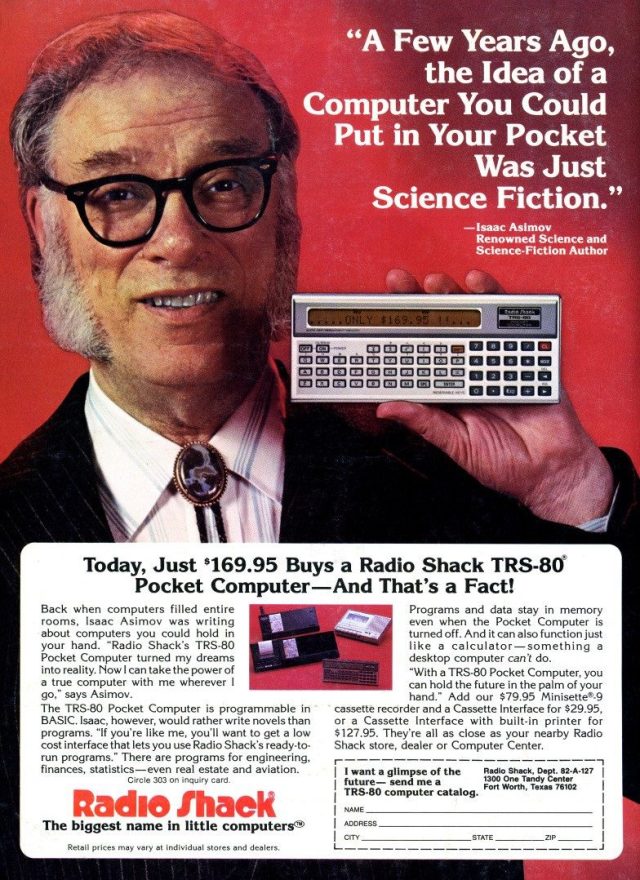LCD – Liquid Cristal Display – was a considerable improvement over LED – Light-emitting Diode – when it came to calculators or pocket computer displays. Undeniably, the significant benefits were: lower power consumption and access to the rich alphanumerical display. The latter is crucial to using more advanced programming languages such as BASIC, C, or Pascal vs. keystroke programming. In other words, everything we love in our vintage pocket computers.











Unfortunately, it turns out that LCDs age poorly, and where it is common to find 50 years old calculators with flawlessly functioning LED displays, the early LCDs are systematically fading away, plagued with many curses. One of them I shared about several times (here , here, and here) is the Black Oil. This common curse attacks preferably early LCDs – often recognizable by their yellow protective filters. The SHARP PC-1211 and its licensed version, the TRS-80 Pocket Computer, are the cannon of these problematic displays. In my investigations, I shot several videos under the microscope to better examine the damage. You can find a playlist below.
For years, so-called Grey LCDs were thought to be immune to the disease. Que Nenni! It turns out that those more recent displays also suffer from Black Oil. Interestingly, SHARP devices are more prone to illness than CASIOs. For example, I have never seen a CASIO FX-702P with failing LCDs, where finding a pristine PC-1211 is exceptionally rare these days. Luckily, Robert Baruch brought us replacement LCDs allowing us to rejuvenate our venerable systems since he has replacement displays for the PC-1245, PC-1246/7, and EL-5100. Thank you! Although I can fix my PC-1211, I will keep it original as long as possible. So, this solves the problem of the LCD itself.



Recently, I acquired from Japan a CASIO FX-890P. I am fond of this pocket computer for several reasons, and I already wrote a bit about it here. I like it first because it is the last and most recent model released by CASIO that we can program in BASIC, CASL, Assembler, and C! For your information, I took on a quest to collect every pocket computer natively programmable in C language a decade ago. Today I finished that quest – I will write about this quest later in my blog – and the FX-890P is the best model in that collection.


From the hardware point of view, the 16-bit Intel 80L188EB CPU @ 4MHz undoubtedly has something to do with it, but it is its LCD that I will focus on today. Indeed, contrary to its twins, the CASIO Z1/Gr/a, the FX-890P, was intended for the general public. The Z series was primarily available to academia. Consequently, the 890P’s LCD quality is far superior to the Z1s. Clarity and contrast come at an extra cost.




When I acquired my second FX-890P, I knew it was a used one and that the unit had undergone extensive modifications. First, the main RAM chip on the motherboard was replaced to increase the storage capacity to 256KB, allowing for even more RAM extension via the module (PR). But what caught my attention was the use of the expression ビネガー症候群, which translates into vinegar syndrome. The seller mentioned he reworked the LCD to get rid of ビネガー症候群. Intrigued, I assumed he was referring to the Black Oil, and he swapped it out for a modern replacement. Cool, an even better display for my favorite pocket computers, and an opportunity to learn about something new in the field.





But I was wrong again. Out of conscience, I researched, and to my surprise, LCDs seem to indeed suffer from vinegar syndrome. It seems to hit the HP 200 LX especially – but not only. I found several blog entries, in Japan mainly, about the problem. I recommend you read this one here. It turns out that where the Black Oil attacks the LCD per se, the vinegar syndrome prefers the polarization filters of the LCD. Not quite the same. And the repair is possible, although cumbersome. It boils down to removing the polarization filter and replacing it. The good news is that these filters can be found readily and even exist in various colors, which opens up some exciting tunings down the road. The bad news is the pain of removing the glue used to assemble the LCD and polarizer/filter sandwich. A bit like removing the bezel around the PC-1211 screen when replacing the LCD. A hefty dose of elbow grease and chemical is required. The most enraging in this situation is that the darn glue didn’t age poorly 😉. To conclude on a lighter note, with the Black Oil and the vinegar syndrome, we now have a nice LCD vinaigrette at hand! Bon appétit.

I will have to look for and order an EL5100 display. I just looked at mine and it is now 75% black. My understanding is that the problem is the liquid crystal leaking / evaporating from the display which is why it usually starts to fail around the edges where the display is sealed. I also read in a book about Commodore about them filling Liquid Crystals (and it being a very smelly process).
Some something I have wondered and Googled about each time I have looked at my EL5100 is whether you could refill an LCD. The first hurdle would be actually getting hold of liquid crystal (as in the liquid) in non industrial quantities.
Hi Duncan. I hope you can fix your EL-5100, it is a beautiful system and it definitively worth it. Keep in mind that – at least for the 1211, I have not seen the replacement on the other LCDs (yet) – that the system will likely look different. Maybe it is more visible on the 1211 since the filter is not needed. Regardless, I think it is the best option. I don’t think the refill option is possible or even could work. Please keep us updated with your result.